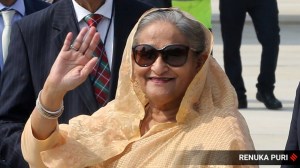This Word Means: Junta
Every day, 500 words on a word (or expression) that has appeared in The Indian Express
 The word junta originates from Spanish, meaning “meeting” or “committee”.
The word junta originates from Spanish, meaning “meeting” or “committee”. Why now?
A day after Myanmar was struck by an earthquake of magnitude 7.7, killing more than 1,600 people, Prime Minister Narendra Modi on Saturday (March 29) conveyed his condolences to the country’s military junta chief, Senior General Min Aung Hlaing.
The junta chief seized power in a coup that took place in February 2021, overthrowing the democratically elected government of Aung San Suu Kyi’s party.
What does ‘junta’ mean?
The word junta originates from Spanish, meaning “meeting” or “committee”. The term was widely used in 16th-Century Spain to refer to various government advisory committees as a junta. In 1808, national and local juntas were organised as part of Spain’s resistance against Napoleon’s invasion. In the following years, the word junta was used to describe governing bodies that emerged during political instability in Spain, Greece, and Latin America.
Subsequently, the term became associated with military rule. Notably, it is different from a military dictatorship. While a junta involves a military cabinet acting as the agent of the ruling military organisation, military dictatorship “involves a military president not acting as the agent of the military and perhaps even converting the military into an instrument of his personal rule,” Paul Brooker wrote in Non-Democratic Regimes (2000).
In the 20th Century, military junta was frequently witnessed in Latin America. But it was different from juntas elsewhere in the world. “An institutionalised, highly corporate/professional junta became the norm in Latin America, with the core membership being the heads of the three armed services — army, navy and air force,” wrote Brooker. The juntas outside Latin America, however, had 11 members on average.
What is the history of the junta in Myanmar?
Myanmar gained independence from British colonial rule in 1948, and began as a parliamentary democracy. But in 1962, General Ne Win led a military coup and held power for the next twenty-six years.
After protests in 2007, the junta introduced a new Constitution, which is still in place today, which gave the military widespread powers even under civilian rule. “The military junta officially dissolved in 2011 and established a military-dominated civilian parliament for a transitional period,” according to a report by the Council on Foreign Relations (CFR).
In 2015, Myanmar held its first nationwide, multiparty elections, and Htin Kyaw, a confidant of Suu Kyi, became the President. Suu Kyi was appointed to the newly created position of state counsellor, and was seen as the de facto head of the government.
In 2020, Suu Kyi’s party, the National League for Democracy, returned to power after another national election. However, in February 2021, the military led a coup and ended civilian rule.





- 01
- 02
- 03
- 04
- 05

































